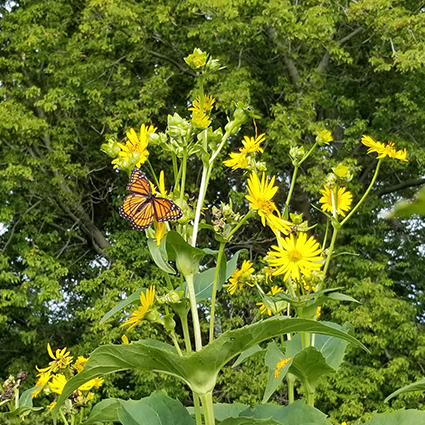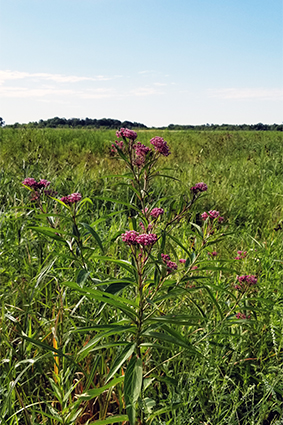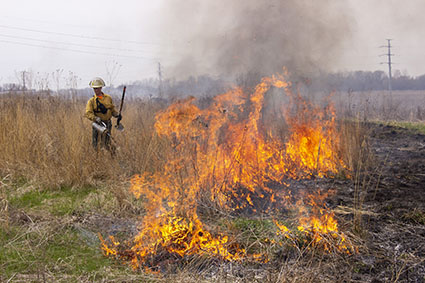Highway Maintenance |
Roadsides |
Landscape management |
Invasive species |
Mowing Wisconsin's roadsides |
Pollinators |
Illegal vegetation cutting and spraying
Wisconsin Department of Transportation's (WisDOT) natural roadsides philosophy began in the 1950s. This philosophy encourages minimal mowing with the use and preservation of native plants when possible. Roadsides provide important habitats for pollinators and native plants. Pollinators and native plants benefit the environment and the state highway system in many ways.
Pollinators:
- Pollinate wildflowers
- Pollinate crops such as cherries, apples and veggies
- Contribute to the health of Wisconsin's ecosystems
Native plants:
- Absorb storm water runoff to reduce pollution, flooding and pavement wear and tear
- Provide optimal erosion control with deeper roots than turf grass
- Preserve Wisconsin's natural beauty and heritage
- Once established, native plants are less costly to maintain than other plants

Natural roadsides philosophy

WisDOT proactively manages right of way land to protect pollinators and native plants. The department preserves existing native vegetation when possible and reestablishes native plants along roadsides.
Mowing
Mowing times are set to control invasive species and protect pollinators. Safety mowing is always permitted. Read more about
mowing Wisconsin's roadsides.
Prairie remnants
There were once 2.1 million acres of tall grass prairies in Wisconsin. Remnants of these original tall grass prairies are found on highway right of ways. Many of these prairie remnants are high quality with undisturbed plant communities.
The Highway Maintenance Manual (HMM) 07-05-30, Managing Prairie Remnants and Native Seeding has detailed information about the department's management of prairie landscapes.
Pollinator gardens
WisDOT is restoring pollinator gardens originally planted during Operation Wildflower in the 1970s. Pollinator gardens are in-process at Safety Rest Areas
11 and
12 along I-39/90/94 in Columbia County and Safety Rest Area
53 along I-94 in Jackson County. More than 30 species of grasses and flowering plants were planted last winter including milkweed, Black-eyed Susans and purple coneflowers.
Monarch Candidate Conservation Agreement with Assurances (CCAA)
In 2022, WisDOT joined the
Monarch CCAA, a
nationwide agreement to promote the conservation of monarchs on land managed by the transportation and energy sectors. Through the Monarch CCAA, transportation and energy agencies across the country are working together to implement land management practices that allow monarchs and other pollinators to flourish.
Pollinator resources:
Burn management of native plants

Prairie fires were once common in Wisconsin. As a result, fire is essential to the well-being of Wisconsin’s native plants. Burn management is a cost-effective, efficient and environmentally sound strategy of managing native plants and preventing invasive species from spreading.
What is a prescribed burn?
Prescribed burns are the skillful application of fire to natural fuels in a definite area under precisely defined conditions (including wind speed and direction, fuel moisture, soil moisture and other factors) in order to produce the intensity of heat and rate of spread required to accomplish the desired result.
WisDOT conducts prescribed burns on roadsides, prairie remnants and wetland mitigation sites with native plants. Typically, prescribed burns occur every two to five years. Locations with more weeds can require more frequent burns.
Impact of Controlled Burns
- Stimulate growth of native grasses and wildflowers
- Improve habitat and food sources for wildlife
- Lengthen the growing season for native plants
- Shorten the growing season for invasive species
- Releases nutrients into the soil
When do controlled burns take place?
Early spring, from late March to early May is the best time for prescribed burns. Controlled burns may also take place during late fall, from late October to early December. Most burns take place in the morning after the dew evaporates but before winds pick up.
Safety during prescribed burns
The safety of the traveling public and nearby residences is the highest priority during any use of prescribed fire. Local fire departments and law enforcement agencies are alerted before prescribed burns. All controlled burns are conducted in accordance with standards set by the
Wisconsin Prescribed Fire Council.
More information: